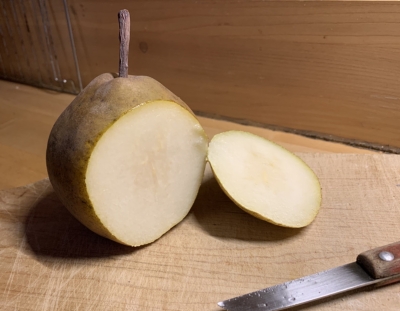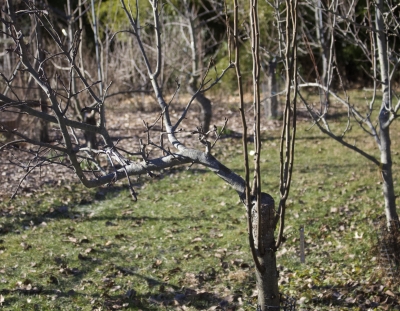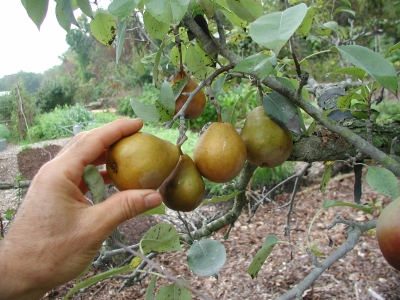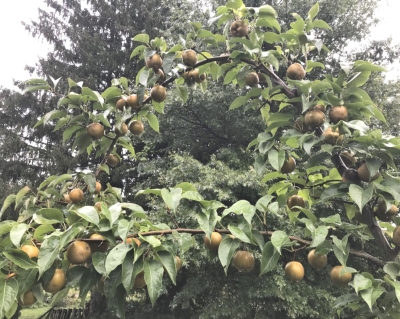A PEAR, 170 YEARS LATER
A Luscious Fruit in Winter
All fruits did well this past season but it was especially a banner year for pears. Why do I mention this now? Because we’re still eating them and they are delicious. “Them” is actually just one variety — Passe Crassane, not a variety you’d find on a supermarket shelf, but which is available as a tree.
Timely harvest, storage, and ripening of pears melds art and science; since this was my first crop from Passe Crassane, I was wary as I sliced off a taste. It was like slicing through butter, a good omen. The flesh was “white, fine. melting, [sugary], perfumed, and agreeably sprightly,” to quote from The Pears of New York, U. P. Hedrick’s 1921 classic. Delicious.
The seed for this pear was sown, literally, by one Louis Boisbunel in Rouen, France in 1845. Ten years later, the tree showed its worth and the fruit made its debut. Passe Crassane is a winter pear that needs to be harvested mature — here, in early November — and then kept in cold storage for a couple of months to ripen to full flavor. Under ideal storage conditions, fruits keep well for months.
This variety was very popular in its century of origin, and its cultivation spread to Italy, Spain, Germany, and England. Commercially, stems were dipped in a red wax to prevent water loss during storage; those red-tipped stems became a signature of Passe Crassane. By the 20th century, Passe Crassane had fallen out of favor because of its susceptibility to diseases, including dreaded fireblight.
(My tree was struck by what I thought might be fireblight a year and a half ago, so I had drastically lopped it back well below what might have been blighted portions, planning to graft the stump to another variety. Fortunately, one older branch remained below the lopping and that branch, for the first time this past season, bore fruit, heavily. I’ll let the tree re-develop from one of the few watersprouts that shot skyward where the tree was lopped.)
The Hard Part of Growing Pears
Apple, cherry, and other common tree fruits are usually beset with pest problems that make them hard to grow. Not so for pears. The hard part about growing pears is knowing when to harvest them and then ripening them to perfection.
Yeh, yeh, I’ve read all about various indicators that show pears are ready for harvest: 1) When the fruit stalk separates easily from the stem as you lift and twist; 2) When the skin color lightens slightly; 3) When the small lenticels on the skin turn from white to brown; 4) When the first fruits start to drop. And, my favorite, recording the harvest date, once you get it right, and then harvesting on about that date every year.

Picking Seckel pear
No matter what the method, a pear should be firm, not at all soft, once ready for harvest. Pears ripen from the inside out. So fruit left on tree to thoroughly ripen is mostly brown mush on the inside by then.
All those indicators notwithstanding, I am much better at timely harvesting of pear varieties I’ve grown and harvested for a number of years.
So much for harvest; now for storage. On or near freezing is ideal. Cold temperatures slow ripening, and, for all except very early varieties, primes the fruit to begin ripening.
Ethylene, a natural, gaseous plant hormone can unduly speed ripening. Mature pears give off very little ethylene; not so for harvested apples and many other fruits, so keep these other fruits away from the pears unless a whole lot of pears are needed ready for eating soon. (I cover ethylene more thoroughly in my book The Ever Curious Gardener: Using a Little Natural Science for a Much Better Garden.)
Finally, on to ripening, which occurs as fruits are brought into warmth, ideally a cool room, 60-70 degrees F. I press a finger against the stem end of the fruit, and if there is any give at all, the fruit is ready for eating.
All this finickiness with harvest, storage, and ripening is unnecessary with Asian pears, which are different species from European pears. Let Asian varieties ripen thoroughly on the tree, meaning they remove easily with a lift and twist, and are fully colored. Then eat. Or keep them refrigerated, and get them out to eat whenever you’re so inclined.

Asian pear, Korean Giant


Lee – Perry Cob planted a wall vine pear tree attached to the Depuy Canal house probably planted around the time we opened. It grew beautifully and one day I attached a jar to one of the pear sprouts and what do you know the results turned even more beautiful. When the pear was rip looking I pluck the pear leaving it in the jar detached from the tree. I then filled the jar with brandy.
I did this jarring over 30 years ago and I still have the pear in the jar. After I successfully attended the property closing willing the property for the Depuy house to becoming the valid museum for the canal society to own. For many reasons I disconnected my involvement with the organization. However you should know they immediately went on a cutting down spree cutting down the pear tree, mulberry, decorative quince bush and many flower bearing vines. I can send you pictures of the pear in jar, if you wish.
Yes, I would be interested in seeing a photo. But what is a “vine pear?”
Thank you Mr. Reich for writing about your special pear tree and its fruits. I will keep pear in the back of my mind when I go to the nursery in the spring and on. I have never grown a fruit tree yet. Maybe, next year.
I wish you healthy health and happiness throughout the year.
Best regards,
Han
You’re probably not going to find that variety easily, probably not at a local nursery.
We have a pear(pineapple) on the farm that at least
100 years old. It was full grown with a rotten heart wood when I was ten years old. It growing like a number seven or one side deer antler. It’s a wonder it is still standing, I will be sixty two this year.
How cool to have seen the tree grow.
Lee, I have a pear question for you: I planted one each of GOlden SPice, Tyson and Hudar in the spring of 2013, all trees from St Lawrence Nurseries. They are on a south facing mild slope with plenty of sun and a good windbreak. They are lovely trees, but barely have any blooms, and so far I have gotten a total of 3 fruits!! I have heard that pears an take a long time to produce. Is this true? I only prune lightly mostly water sprouts or otherwise straight upwards growing branches.
Yes, pears are notorious for taking a long time to begin bearing. Rootstocks affect bearing age. I believe St. Lawrence uses seedling rootstock. Trees on seedling rootstocks do take a long time to bear. A decade would not be surprising.
Lee I understand that a pear DEVOR PEAR I purchased a 1/2 bushel back in The days beginning with Elizabeth Ryan at her orchard in Dutchess County. can you tell me more about the DEVOE PEAR.
Quoted from the USDA Germplasm Repository website, Devoe pear is “Pretty enough to pose for a still life, creamy flavor with a hint of vanilla. Originated in Marlboro, New York, by Charles A. Greiner in 1947. Thought to be a seedling of Clapp Favorite. Fruit: elongated shape similar to Bosc, coloring similar to Clapp Favorite; attractive bright red spotted blush. Flesh soft, fine, buttery, tender, melting, white to yellow, subacid; stone cells absent. Harvest in mid-September, about 2 weeks after Bartlett. Tree: vigorous; tolerant to fire blight and pear psylla, susceptible to scab.